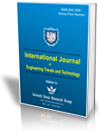A Fuzzy MPPT Based Voltage Regulator Integrated Asymmetrical Multi-Level Inverter Standalone PV Source
A Fuzzy MPPT Based Voltage Regulator Integrated Asymmetrical Multi-Level Inverter Standalone PV Source |
||
 |
 |
|
| © 2025 by IJETT Journal | ||
| Volume-73 Issue-10 |
||
| Year of Publication : 2025 | ||
| Author : Rampalli Jagan, Bhaskar Kanna | ||
| DOI : 10.14445/22315381/IJETT-V73I10P102 | ||
How to Cite?
Rampalli Jagan, Bhaskar Kanna,"A Fuzzy MPPT Based Voltage Regulator Integrated Asymmetrical Multi-Level Inverter Standalone PV Source", International Journal of Engineering Trends and Technology, vol. 73, no. 10, pp.10-21, 2025. Crossref, https://doi.org/10.14445/22315381/IJETT-V73I10P102
Abstract
The replacement of conventional energy sources with renewable alternatives has become a key strategy to mitigate global warming. Among these, PV systems are highly promising due to their flexible deployment and relatively low initial cost. However, PV systems produce fluctuating power and unstable DC voltage since their output depends directly on solar irradiation. To effectively harness PV power, this work integrates a fuzzy logic-based MPPT voltage regulator with an asymmetrical multilevel inverter connected to a standalone PV array. The proposed system employs four PV modules operating at different voltage levels, configured with an asymmetrical 31-level inverter. These voltage levels are combined by a level generator to produce 15 distinct voltage steps, which are then inverted using a four-switch full bridge. A comparative study is conducted between the conventional MPPT P&O method and the FL-based MPPT regulator. The results highlight the superior performance of the fuzzy MPPT approach in achieving optimal control for the standalone PV inverter, as demonstrated by higher extracted power amplitude and reduced tracking time.
Keywords
Photo Voltaic (PV), Maximum Power Point Tracking (MPPT), Fuzzy logic, Perturb and Observe (P&O), Fuzzy Logic (FL), Asymmetrical multi-level inverter.
References
[1] N. Girgibo et al., “Risks of Climate Change Effects on Renewable Energy Resources and the Effects of their Utilisation on the Environment,” Energy Reports, vol. 11, pp. 1517-1534, 2024.
[CrossRef] [Google Scholar] [Publisher link]
[2] Ahmed I. Osman et al., “Cost, Environmental Impact, and Resilience of Renewable Energy under a Changing Climate: A Review,” Environmental Chemistry Letters, vol. 21, no. 2, pp. 741-764, 2022.
[CrossRef] [Google Scholar] [Publisher link]
[3] Yuping Shang et al., “Impacts of Renewable Energy on Climate Risk: A Global Perspective for Energy Transition in a Climate Adaptation Framework,” Applied Energy, vol. 362, 2024.
[CrossRef] [Google Scholar] [Publisher link]
[4] Waqas Ali et al., “Design Considerations of Stand-Alone Solar Photovoltaic Systems,” 2018 International Conference on Computing, Electronic and Electrical Engineering (ICE Cube), Quetta, Pakistan, pp. 1-6, 2018.
[CrossRef] [Google Scholar] [Publisher link]
[5] El Manaa Barhoumi, “Optimal Design of Standalone Hybrid Solar-Wind Energy Systems for Hydrogen-Refueling Station Case Study,” Journal of Energy Storage, vol. 74, 2023.
[CrossRef] [Google Scholar] [Publisher link]
[6] Hussein Mohammed Ridha et al., “Optimum Design of a Standalone Solar Photovoltaic System Based on Novel Integration of Iterative-PESA-II and AHP-VIKOR Methods,” Processes, vol. 8, no. 3, pp. 1-30, 2020.
[CrossRef] [Google Scholar] [Publisher link]
[7] Faizan Arif Khan, Nitai Pal, and Syed Hasan Saeed, Chapter 31 - Stand-Alone Hybrid System of Solar Photovoltaics/Wind Energy Resources: An Eco-Friendly Sustainable Approach, Renewable Energy Systems, Academic Press, pp. 687-705, 2021.
[CrossRef] [Google Scholar] [Publisher link]
[8] Devalraju Prasad et al., “Design and Implementation of 31-Level Asymmetrical Inverter with Reduced Components,” IEEE Access, vol. 9, pp. 22788-22803, 2021.
[CrossRef] [Google Scholar] [Publisher link]
[9] J. Gowri Shankar et al., “A 31-Level Asymmetrical Cascaded Multilevel Inverter with DC-DC Flyback Converter for Photovoltaic System,” 2017 International Conference on High Voltage Engineering and Power Systems (ICHVEPS), Denpasar, Indonesia, pp. 277-282, 2017.
[CrossRef] [Google Scholar] [Publisher link]
[10] R.K. Rai, and O.P. Rahi, “Fuzzy Logic based Control Technique using MPPT for Solar PV System,” 2022 First International Conference on Electrical, Electronics, Information and Communication Technologies (ICEEICT), Trichy, India, pp. 1-5, 2022.
[CrossRef] [Google Scholar] [Publisher link]
[11] Nitin Singh, and Ranjeeta Khare, “A Review Asymmetrical Multi-level DC-link Inverter for PV Energy System Based Voltage Regulator,” International Journal of Engineering Applied Science and Management, vol. 5, no. 9, pp. 1-6, 2024.
[Google Scholar] [Publisher link]
[12] Bolla Madhusudana Reddy, P.B. Chennaiah, and J. Chinnababu, Modelling of Symmetrical 13 Level and Asymmetrical 31 Level Generalized Cascaded Multilevel Inverters, Modern Approaches in Machine Learning and Cognitive Science: A Walkthrough. Studies in Computational Intelligence, Springer, Cham, pp. 169-191, 2024.
[CrossRef] [Google Scholar] [Publisher link]
[13] Muhammad Najwan Hamidi et al., “Asymmetrical Multi-Level DC-link Inverter for PV Energy System with Perturb and Observe Based Voltage Regulator and Capacitor Compensator,” Journal of Modern Power Systems and Clean Energy, vol. 9, no. 1, pp. 199-209, 2021.
[CrossRef] [Google Scholar] [Publisher link]
[14] Muhammad Najwan Hamidi et al., “Asymmetrical Multilevel Inverter-Based PV System with Voltage Feedback Control: An Experimental Validation,” Applied Science, vol. 12, no. 7, pp. 1-21, 2022.
[CrossRef] [Google Scholar] [Publisher link]
[15] M. Venkateswarlu, G. Panduranga Reddy, and S. Sankara Prasad, “Single Phase Advanced Multilevel Inverter with Reduced Devices and THD for Industrial Applications,” 2023 9th International Conference on Advanced Computing and Communication Systems (ICACCS), Coimbatore, India, pp. 1006-1011, 2023.
[CrossRef] [Google Scholar] [Publisher link]
[16] Gee Varghese Mathew Kurian, P. Aruna Jeyanthy, and D. Devaraj, “Efficient Evaluation of Anticipated 31-Level Inverter for Photovoltaic Energy System with Reduced Switches,” Sustainable Computing: Informatics and Systems, vol. 36, 2022.
[CrossRef] [Google Scholar] [Publisher link]
[17] Kifayat Ullah et al., “Fuzzy-Based Maximum Power Point Tracking (MPPT) Control System for Photovoltaic Power Generation System,” Results in Engineering, vol. 20, pp. 1-10, 2023.
[CrossRef] [Google Scholar] [Publisher link]
[18] B. Bendib et al., “Advanced Fuzzy MPPT Controller for a Stand-alone PV System,” Energy Procedia, vol. 50, pp. 383-392, 2014.
[CrossRef] [Google Scholar] [Publisher link]
[19] Carlos Robles Algarín, John Taborda Giraldo, and Omar Rodríguez Álvarez, “Fuzzy Logic Based MPPT Controller for a PV System,” Energies, vol. 10, no. 12, pp. 1-18, 2017.
[CrossRef] [Google Scholar] [Publisher link]
[20] S. Narendiran et al., “Fuzzy Logic Controller based Maximum Power Point Tracking for PV System,” 2016 3rd International Conference on Electrical Energy Systems (ICEES), Chennai, India, pp. 29-34, 2016.
[CrossRef] [Google Scholar] [Publisher link]

